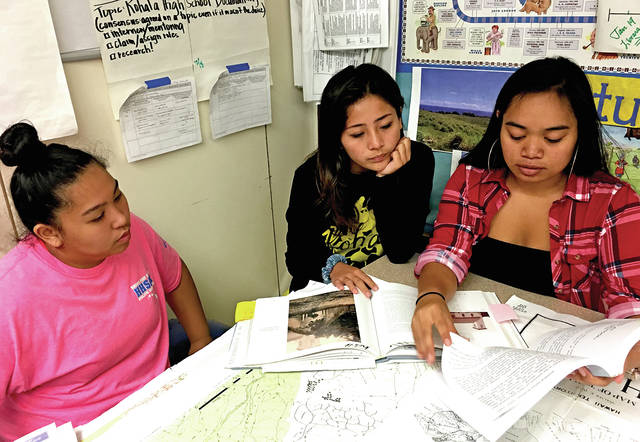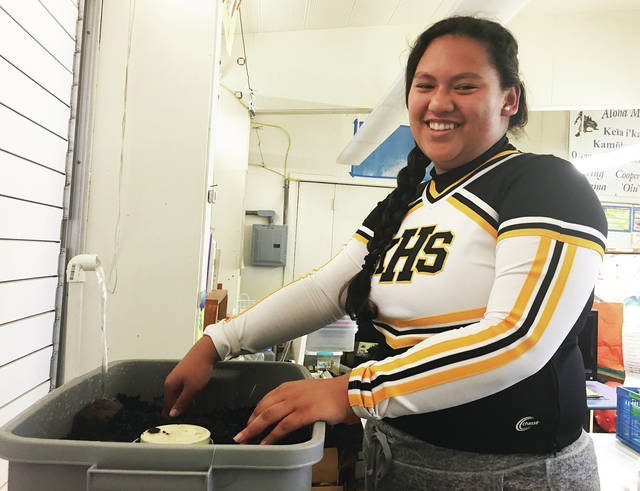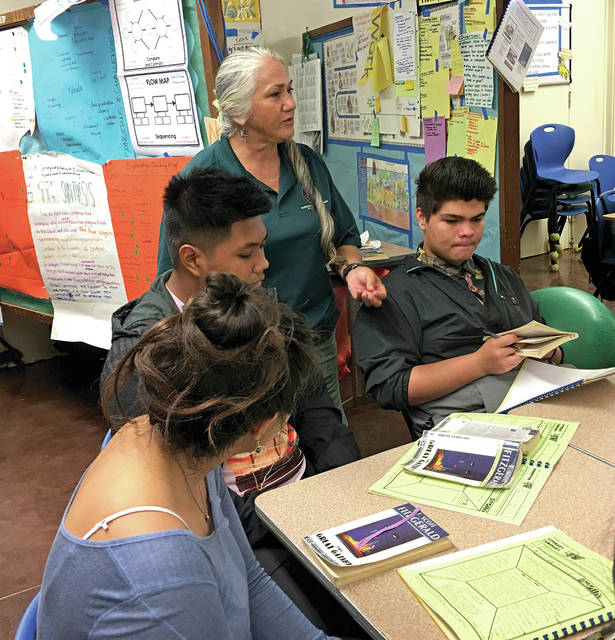KAPAAU — Most people know STEM as a project-based approach to teaching with an emphasis on science, technology, engineering and math.
But STEM can be much more than that, as evidenced by a new class — the first of its kind — offered to multi-grade-level students at Kohala High School (KHS).
“Our focus is STEM but we’re looking at how the English Language Arts (ELA) skills of speaking, listening reading, writing and thinking integrate into what the students want to do with science, technology, engineering or math,” class instructor Fern White said.
Students don’t get a STEM or science credit for being enrolled in her class, but instead get a regular English credit.
“We’re quite the anomaly,” White said. “We’re inventive in the sense that you can Google STEM English class or an English class that’s STEM focused and you won’t find it.”
On any given day, 12 STEM-ELA students file into her classroom and begin various project-based activities. White provides instruction, but loosely; her main interaction with students is encouraging them and acknowledging when they’ve done a good job on a particular task during the time allotted.
According to KHS Principal Janette Snelling, the project-based learning format provides the basis for students to grapple with questions that have real-life relevance and application.
“It is truly an innovative effort to give students a voice in learning, with the teacher serving as a facilitator for learning and as a champion for students challenging themselves to strive higher,” she said.
Created by White, activities are as varied as they are interesting and fun. In a recent class, a small group gathered in a “Literature Circle” to discuss the popular novel “The Great Gatsby” by F. Scott Fitzgerald.
“I love this class,” said student Cheyenne Fuertes.
During the school year students also read “Jungle” by Upton Sinclair and “Of Mice &Men” by John Steinbeck. In the circle, each student is given a workbook and assigned a role to aid their group discussion.
They are evaluated and complete a self-assessment on their abilities to stay on task, use their time wisely, re-focus when needed and accomplish their goals and tasks. Group expectations include intellectual courage or respectfully challenging others; intellectual leadership or taking the initiative to help others with learning; and intellectual humility, or making sure not to steal others’ opportunities to learn and think.
In an adjacent corner of the classroom, two students work on hydroponics, or the cultivation of plants in water rather than soil. It was this subject matter that spurred Sadey Alip to enroll in the STEM-ELA course.
Now a junior, she said she first learned about hydroponics through a STEM experience she had in the eighth grade.
“When Ms. White offered to do it in this class, I jumped at the opportunity because I’ve always been fascinated by it,” Alip said.
An individual task students can take throughout a class period is building and operating a mini robotic car. The self-paced activity teaches students basic electrical knowledge and circuitry. Each has a breadboard and learns how to manage energy with a capacitor and a resistor.
A class project takes place in the Hokupaa or “guiding star” meeting space. In this activity, students learn about their community, state and the world, and acquire real-world work skills. For their Hokupaa project, the STEM-ELA students are producing a documentary of Kohala High School.
“We’re trying to tell the story of how the school has changed, the past, present and future, so we’re documenting people’s stories and what their experiences here were like,” student Miranda Canniff said.
Fuertes noted the project has provided an opportunity for her and others to use all the skills they have learned in STEM-ELA including research, investigation, experimentation and presentation in the form of the final product.
Several STEM-ELA students serve on the Hokupaa Youth Council, a multi high school organization with representatives from West Hawaii high schools KHS, Kealakehe, Konawaena and Honokaa. Council participants seek to elevate student voices on issues they feel are most important, and are encouraged to connect with a community member or business person for help with their projects.
Uncle Richard Gonzales, the West Hawaii facilities supervisor and production specialist at Na Leo TV, is a community member working with KHS. He meets with the Hokupaa team every Wednesday, and has provided training and equipment needed to produce the documentary including cameras, lighting, microphones and green screens. He has also taught the students how to interview people on camera, be interviewed and do public service announcements.
The classmates hope to finish their documentary by March 9 to show at the first annual Kohala School Jamboree.
Throughout the semester, all classwork is completed against a question designed to encourage and elicit deeper thinking. Written on the classroom’s white board, it says, “Can we achieve the American Dream and still maintain mortality considering the current world of technology?”
Ever mindful of the role of technology and its relationship to various disciplines, White says science, engineering, math and even the arts are all disciplines, but technology is not a discipline; it evolves.
“I see technology as a moving target that gives you the flexibility to move in and out of the other disciplines,” she said. “And that’s where STEM-ELA folds into the skill building, to do things at a level that improves a student’s skill base with greater efficiency and clarity, and with the ability to articulate more clearly and with more depth.”
In the STEM-ELA course, a blend of English standards with STEM standards occurs. Students earn grade level or Advanced Placement English credits by meeting those standard while focusing on STEM-based projects.
“Students understand they need to achieve and process through some amount of prescriptive inquiry, while remaining cognizant of their own responsibilities to themselves, their classmates and their learning,” White said.
“I love discovery learning,” she continued. “I try to give students some structure but followed by release. It’s an engaging and exciting way to teach and learn.”
Studies have shown that young people engaged and excited move from having low expectations and few aspirations to thinking more about their futures and careers.
“Teaching is so important, so challenging, so exciting, and ever-changing, yet always perhaps the greatest contribution we can make to our world. If I can help one student soar to greater heights than even they expect, I am rewarded and most happy,” White concluded.








